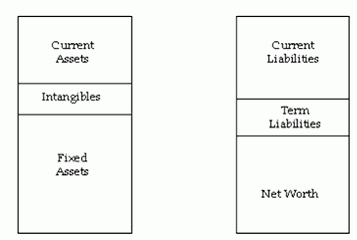The Balance Sheet
Category: Financial Risk Management
A Balance Sheet is a statement in money terms of what a business owns and owes at a point in time.
What a business owns are called Assets.
What a business owes are called Liabilities.
The difference between these (i.e. Assets minus Liabilities) is the owner’s stake in the business or the Net Worth.
As its name implies, a Balance Sheet must always be in balance as illustrated next
Assets = Liabilities + New Worth
The Contents of the Balance Sheet
While the manner in which a Balance Sheet is represented may vary, next shows the main constituent elements graphically:
As long as the business is trading, the size of the component parts will be continually changing. However, the height of the two bars in Slide 5 will always be equal.
The Assets
We generally have three categories of assets; as shown in Slide 4. Let us look at these in a little more detail. (It will probably be helpful to use the flipchart to write down the principal examples under each heading).
Current Assets
These are assets that are the same as cash or are expected to be converted into cash in the near future (i.e. generally the following 12 months.)
Typical current assets are:
Stock
Debtors
Short Term Investments
Bank Credit Balances
Intangible Fixed Assets
These are assets that do not have a physical existence. They are created by expenditure in one period that is expected to provide a benefit (i.e. generate profit and cash) over a number of future periods.
Some typical examples would be:
Goodwill: usually created where a business is bought for more than its Balance Sheet Net Worth.
Research and Development
Patents
Trade Marks
Tangible Fixed Assets
These are assets that are not sold in the ordinary course of business but, rather, are retained in, and used by, the business for many years.
Typical examples of tangible fixed assets would be:
Land and Buildings
Plant and Machinery
Fixtures and Fittings
Motor Vehicles
Long Term Investments
Generally, apart from the Long Term Investments, fixed assets are depreciated, or written off against profits, over their useful life. They appear in the Balance Sheet at their Net Book Value (i.e. Cost less accumulated depreciation).
Liabilities and Net Worth
The Liabilities and Net Worth side of the Balance Sheet is quite straightforward:
Current Liabilities
These are debts of the business that are due for payment in the near future. Examples are:
Bank Overdraft
Portion of Bank Debt due to be repaid within 12 months
Creditors
Current Tax.
Term Liabilities
These are debts of the business that will have to be discharged at some time in the future but not within the next 12 months. Typically, these might include:
Long Term Bank Debt
Repayable Government Grants
Directors Loans
Net Worth
This balancing figure is effectively made up of owners capital input plus profits retained in the business.

